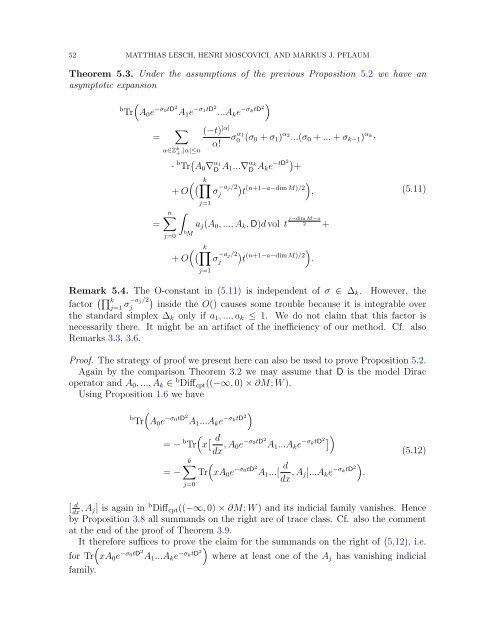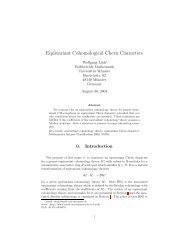Connes-Chern Character for Manifolds with Boundary and ETA ...
Connes-Chern Character for Manifolds with Boundary and ETA ...
Connes-Chern Character for Manifolds with Boundary and ETA ...
You also want an ePaper? Increase the reach of your titles
YUMPU automatically turns print PDFs into web optimized ePapers that Google loves.
52 MATTHIAS LESCH, HENRI MOSCOVICI, AND MARKUS J. PFLAUM<br />
Theorem 5.3. Under the assumptions of the previous Proposition 5.2 we have an<br />
asymptotic expansion<br />
b Tr<br />
(A 0 e −σ 0tD 2 A 1 e −σ 1tD 2 ...A k e −σ ktD 2)<br />
= ∑ (−t) |α|<br />
σ α 1<br />
0 (σ 0 + σ 1 ) α 2<br />
...(σ 0 + ... + σ k−1 ) αk·<br />
α!<br />
α∈Z k + ,|α|≤n<br />
=<br />
· bTr ( A 0 ∇ α 1<br />
D A 1...∇ α k<br />
D A )<br />
ke −tD2 +<br />
( (<br />
k∏<br />
+ O σ −a )<br />
j/2<br />
j t<br />
(n+1−a−dim M)/2)<br />
,<br />
n∑<br />
∫<br />
j=0<br />
b M<br />
j=1<br />
j−dim M−a<br />
a j (A 0 , ..., A k , D)d vol t 2 +<br />
( (<br />
k∏<br />
+ O σ −a )<br />
j/2<br />
j t<br />
(n+1−a−dim M)/2)<br />
.<br />
j=1<br />
(5.11)<br />
Remark 5.4. The O-constant in (5.11) is independent of σ ∈ ∆ k . However, the<br />
factor (∏ k<br />
)<br />
j=1 σ−a j/2<br />
j inside the O() causes some trouble because it is integrable over<br />
the st<strong>and</strong>ard simplex ∆ k only if a 1 , ..., a k ≤ 1. We do not claim that this factor is<br />
necessarily there. It might be an artifact of the inefficiency of our method. Cf. also<br />
Remarks 3.3, 3.6.<br />
Proof. The strategy of proof we present here can also be used to prove Proposition 5.2.<br />
Again by the comparison Theorem 3.2 we may assume that D is the model Dirac<br />
operator <strong>and</strong> A 0 , ..., A k ∈ b Diff cpt ((−∞, 0) × ∂M; W ).<br />
Using Proposition 1.6 we have<br />
b Tr<br />
(A 0 e −σ 0tD 2 A 1 ...A k e −σ ktD 2)<br />
(<br />
= − b Tr x [ d<br />
dx , A ] )<br />
0e −σ 0tD 2 A 1 ...A k e −σ ktD 2<br />
= −<br />
k∑ (<br />
Tr<br />
j=0<br />
xA 0 e −σ 0tD 2 A 1 ...[ d<br />
dx , A j]...A k e −σ ktD 2) .<br />
(5.12)<br />
[ d , A dx j] is again in b Diff cpt ((−∞, 0) × ∂M; W ) <strong>and</strong> its indicial family vanishes. Hence<br />
by Proposition 3.8 all summ<strong>and</strong>s on the right are of trace class. Cf. also the comment<br />
at the end of the proof of Theorem 3.9.<br />
It there<strong>for</strong>e suffices to prove the ) claim <strong>for</strong> the summ<strong>and</strong>s on the right of (5.12), i.e.<br />
<strong>for</strong> Tr<br />
(xA 0 e −σ 0tD 2 A 1 ...A k e −σ ktD 2 where at least one of the A j has vanishing indicial<br />
family.

















